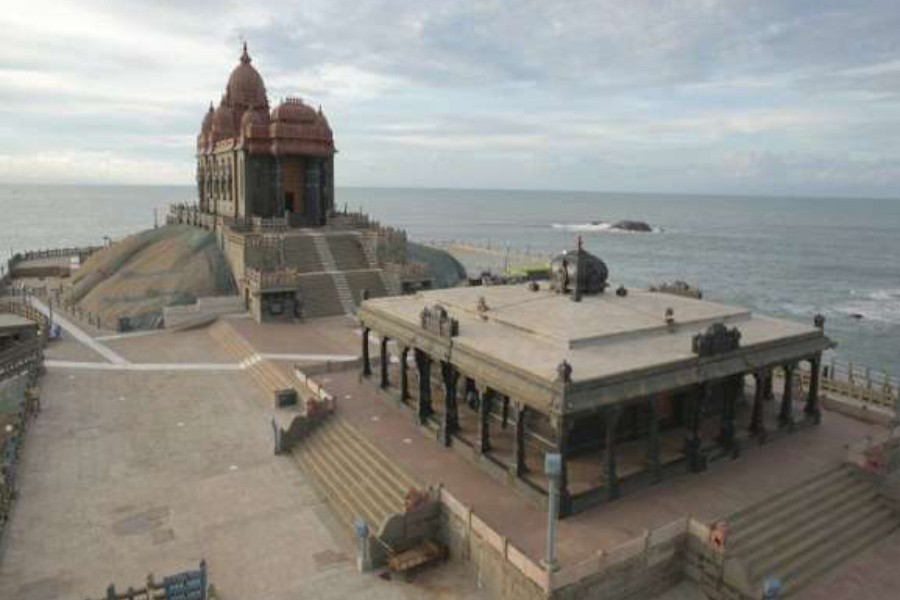The full-day package tour arranged by the Vivekananda Kendra could not be more cherishing. Although Kerala is our destination, we begin from a temple called Suchindram Thanumalayan. Like most temples, this one is also a magnificent artwork of Dravidian architecture. Brahma, Vishshnu and Shiva, the trinity of the Hindu pantheon coexist here. Immediately after our entrance into the temple, one of the sanyasis clad in saffron-coloured dhuti volunteered to explain the religious significance of the temple. I skip the details but the gist of his lecture is that it has statues and artwork of silver and bronze unlike the Padmanavaswamy Temple in Trivandram (Thiruvanthapuram) where those are crafted with gold.
Although Vishnu and Shiva dominate most south Indian temples, here Brahma has been duly given his share at the base of the temple. A Ganesha statue has also been ensconced in one of the niches. But the largest monkey God Hanuman has a popular attraction here. Everyday a huge garland is put round the statue's neck. We were present at the time, the previous day's one was replaced by a fresh one. I had a hunch, this statue was a late addition because the statues inside and those on the temple walls outside are so exquisitely chiselled that they leave one wondering at the perfect shapes. But the Hanuman's statue was a rough cut of later days.
However, the sanyasi who took upon himself the duty of showing and explaining the intricacies of the temple took us to what serves as pillars. All these look like solid rocks but the man in saffron soon let us realise how mistaken we were. There are two statues and supports of round pillars in between. He struck one of the pillars and it sounded like the 'sa' on the musical instrument 'Tabla'. Then he continued striking the pillars and they produced perfect Indian musical notes of sa, re, ga, ma, pa, dha, nee. The impression was that the pillars are hollow inside. How can rock pillars be hollow? I wondered. Then he brings us to another statue and inserts through its two ears a thin stick. Were the statues and pillars cut out in pieces and then joined together? Or, how can those be empty inside?
Well, outside on the walls the stories of Ramayana and Mahabhrata are depicted. But the temple stands so majestically tall that the statues on its walls look small. The temple radiates a silvery aura under the bright sun. On completion of his guidance, we now realised that the service was not voluntary. I thought we should offer him some token money but he demanded Rs 500. We gave him Rs 300.
Then our driver Stephen took us to Kerala for backwater boating. Speedboats can be hired on hourly basis for sightseeing on the backwater that meanders through a mangrove forest. The forest has no big cats nor fierce animals except snakes, we were told. The water is mostly clear and where it is shallow one can see the bottom. We watched for unfamiliar birds but apart from cormorant and egret and herons nothing could be seen. However, it was the trees that puzzled us most. There were fruits like mangoes on trees but our boatman told us those are poisonous. Then there were fruits like beads or conical and of strange shapes.
However it was not until we reached the golden sand beach that our appetite for something not seen before fully satisfied. Here the granules of sands are big and of golden colour and hence the name Golden Beach. We stood confronting the majestic Arabian Sea breaking in huge waves before us, at our feet. The endless expanse of the emerald colour water leaves one speechless and spell-bound. One realises one's smallness before the immeasurable, the vast store of life's basic ingredient. One cannot be blamed if the usual sense-perception is found not to coordinate properly. A universal force is at work where the existence of a superior force far beyond life's grasp prevails upon one's small self. Did Dwijendralal feel the same way when his heart was enlightened in ecstasy: "Oi mahasindhur opar hote, kee sangeet bhese ase (from across the great ocean what melody comes along)".


